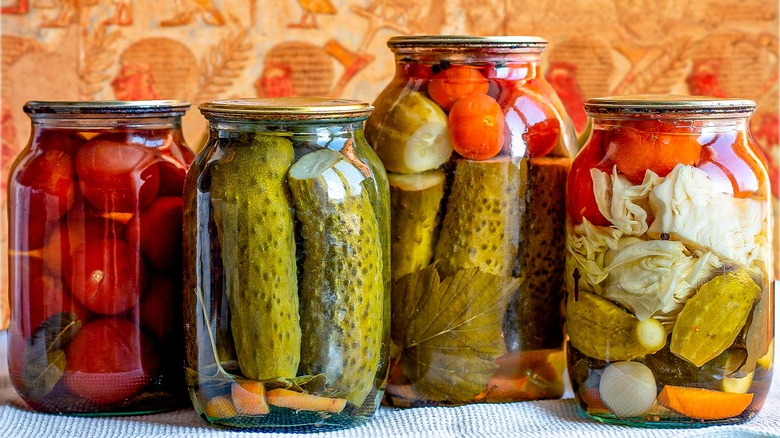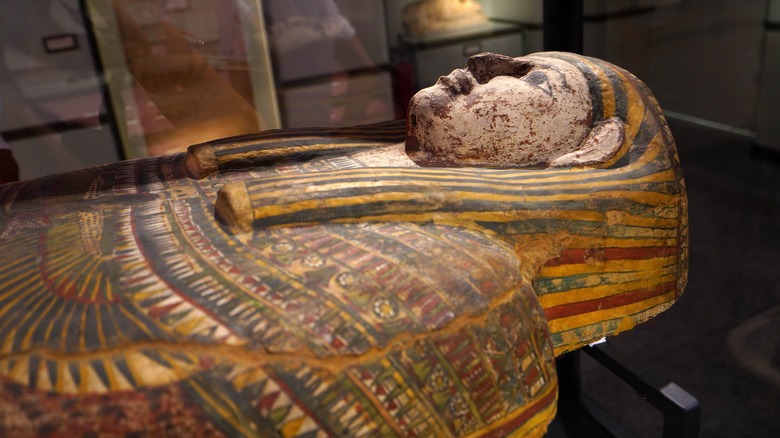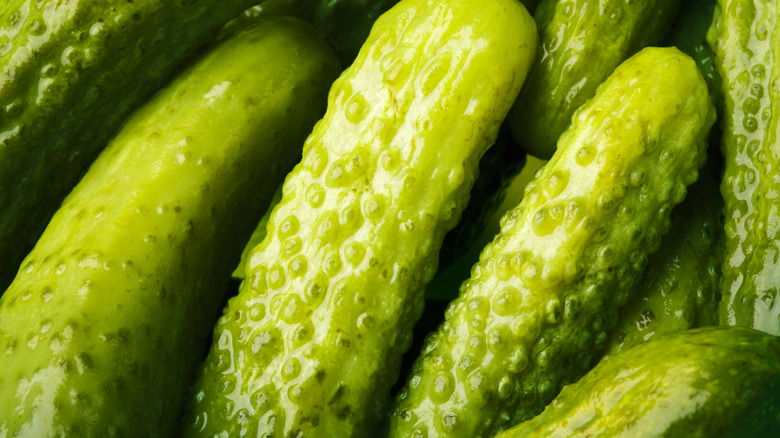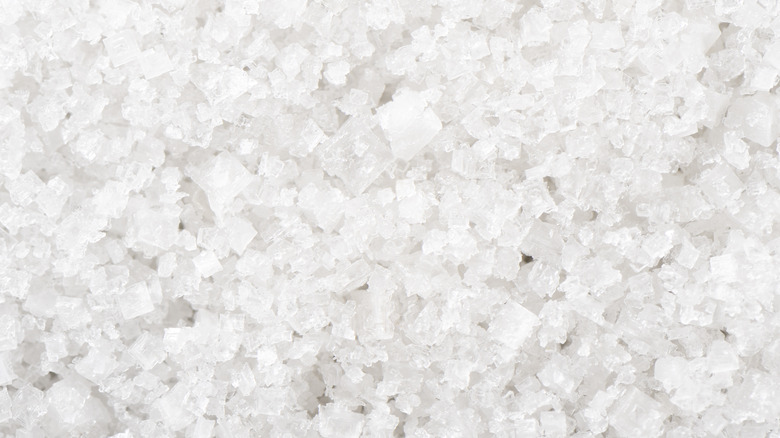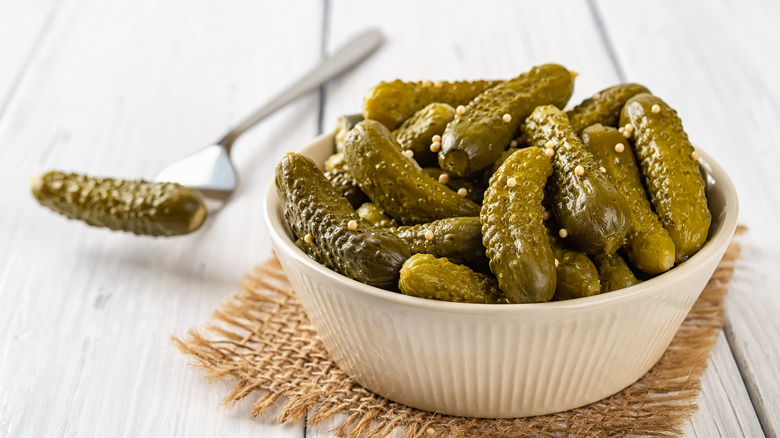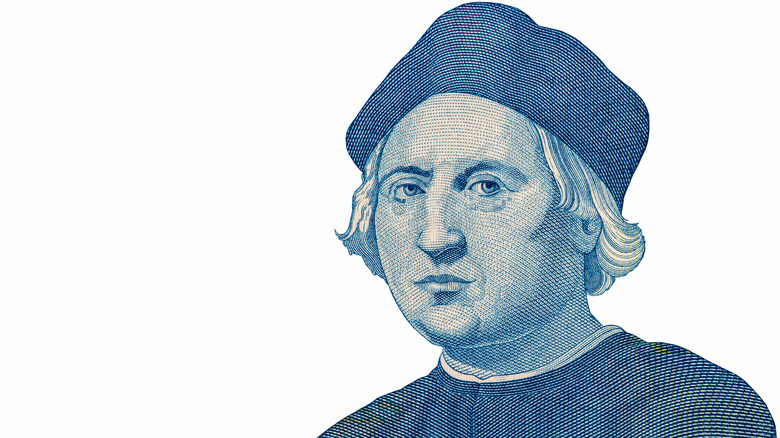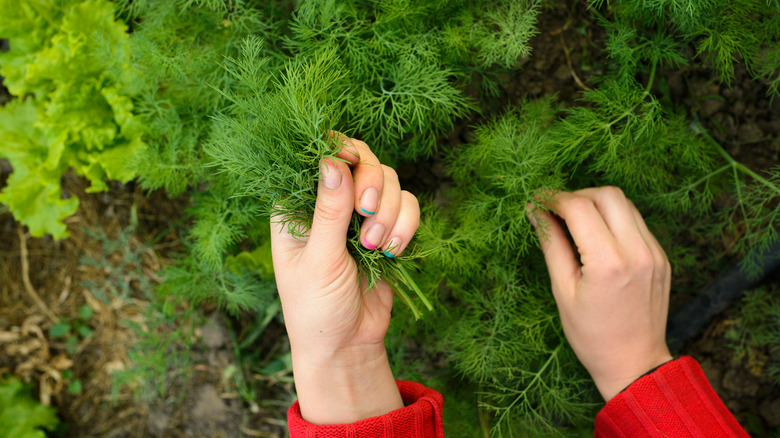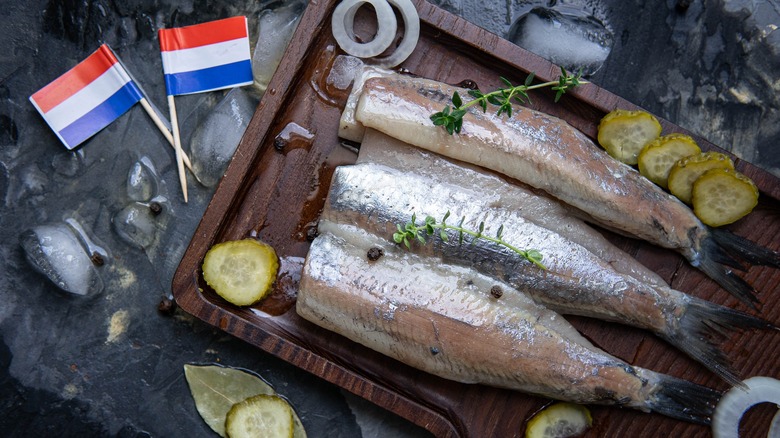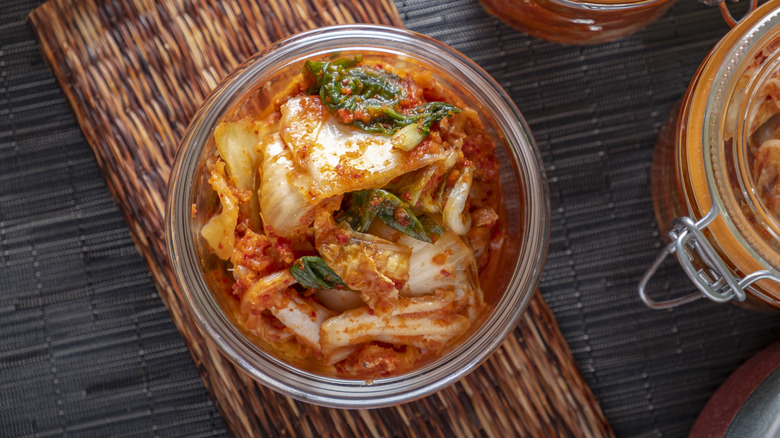The Ancient Egyptian Origins Of Pickling Food
When you look into your fridge, there are a few items that it's impossible to imagine it not containing. We're willing to wager that one of those items is a jar of pickles.
Pickles (and pickled food products) are a fundamental element of cuisines, both in the United States and across the world. In 2020, over 245 million Americans ate pickles at some point, according to Statista. And it seems like innovative chefs are finding unique foods to pickle and serve every single day, with pickled strawberries a key food trend predicted to make a splash in 2023 (per Datassential).
But this constantly evolving method of preparing food has fascinating roots, and it might surprise you just how far back the history of the humble pickle goes. Dating back some 4,000 years and beyond, pickling food was a key element of ancient cultures, including the ancient Egyptians. But what did the first pickled foods look like? And how did the vital food prep method pass down through cultures and generations, to end up in that jar you picked up from the store this afternoon? Join us as we take a deep dive into the world of pickles and their intriguing journey through the centuries.
As a form of food preparation, pickling began thousands of years ago
Although pickling arguably has its strongest roots in Ancient Egypt, it's proposed that it may have begun in a different place — and culture — entirely.
The act of pickling items, particularly cucumbers, in vinegar or another acidic brine is said to have started with the ancient Mesopotamians. Both the Mesopotamian and Egyptian historical cultures developed at a similar time, with the Mesopotamians contributing astonishing firsts to human civilization, including the first form of written language, early forms of maths, and some of the first cities ever built. And, apparently, pickles as well. How's that for a cultural legacy?
It's argued that the Mesopotamians were pickling items as early as 2030 BC, in the Tigris Valley that the civilization called its home. Pickling was used as it is today: as a means to preserve food items and extend their lifespan, making them edible when they were out of season or on longer trips. Given the relative closeness of ancient Mesopotamia and ancient Egypt, trade was common between the two worlds. And regardless of which civilization originated pickling as a practice, we'd guess that a few containers of pickles likely changed hands at some point.
In ancient Egypt, pickling was a common form of food preservation
Ancient civilizations didn't have all the modern conveniences we do for storing and preparing food, and so they had to be canny. And it was likely the resourcefulness of the ancient Egyptians that led to the rise of pickling foods.
Pickling was one of the go-to ways of keeping food edible in these communities, and a large range of items was preserved. Notably, while modern tastes are typically more suited to pickled vegetables, the ancient Egyptians would commonly pickle proteins like poultry and fish. Evidence of pickled fish bones was part of several archeological discoveries around sites where the ancient Egyptians lived. Some of the bones were in jars, giving further information about the methods used.
Interestingly, the act of pickling fish was such a treasured skill in ancient Egyptian culture that it was typically only performed by temple officials. Vegetables were also on the menu, of course, and virtually anything that could be cured in salt or pickled in brine was prepared in that manner. Pickling allowed the ancient Egyptians not only to eat out of season, but to sell and trade food as well.
Ancient Egyptian pickling practices linked in with mummification
While the pickling process in Ancient Egyptian culture makes sense on a culinary level (and on a taste level as well — pickling frequently makes food way more delicious), it also makes sense when you think about their other habits. And one of these habits, mummification, is arguably the biggest act of preservation there is.
Mummification was the act of preserving the body, keeping it intact after death, safeguarding the spirit of the deceased person, and allowing them to live on in the afterlife. The ancient Egyptians had several methods of mummification. While we're typically more familiar with the classic image of a body encased in linen bandages, one of the forms of mummification involved mixing a solution of a type of salt called natron with water. The solution that came from doing this would then be used to, in effect, pickle organs and other vital body parts. Pretty interesting, right? While we can't be certain, there appears to be a clear crossover in the knowledge of preparing food and preparing individuals for the afterlife.
Pickles were thought to bring good looks and strength
In ancient Egypt, pickles weren't just prized for their taste and preservability. It was also thought that pickling foods (and subsequently eating them) might imbue the people of Egypt with positive qualities. One such believer in this was none other than Queen Cleopatra, the last ruler of the Ptolemaic Kingdom in Egypt. Cleopatra was an avid consumer of pickles, and credited them with making her beautiful and keeping her in good health.
Cleopatra's belief in the positive power of pickles may have also rubbed off on her partner and fellow ruler Julius Caesar. Caesar felt that pickles had strength-giving qualities. He made pickles a staple of his army's diet, as part of a strategy to help them win battles. Interestingly, Caesar wasn't too far off in this belief. Pickles are naturally abundant in folate, a B vitamin that can help us feel more energized, thanks to its ability to support turning food into energy (per Mount Sinai). Pickles are also high in beta-carotene, which may support skin health and help slow skin aging (via WebMD). Maybe Cleopatra was right about them, after all!
Pickled cucumbers, as we know them, may have originated from elsewhere
Mention the word "pickles," and we immediately think of one thing: pickled cucumbers. But while the ancient Egyptians may have had a hand in originating and developing pickling practices, when it comes to the invention of the pickled cucumber itself, there may have been another source.
Ancient Egypt was a civilization that pickled extensively, but much of the evidence points towards proteins like fish and poultry being their favored foods to preserve, as well as fruits like melon. On the other hand, pickled cucumbers appear to have first cropped up in India, as early as 3,000 BC. The plant was a crop native to the northern areas of the country.
It's believed that as people traveled to the West, the crop and its seeds traveled with them, with different names for the cucumber appearing in various ancient languages. Eventually, it made its way to the Mesopotamian region, where archeological evidence points to the appearance of pickled cucumbers made circa 2030 BC. Over time, pickled cucumbers also showed up in ancient Egypt and subsequent areas, passed down through the years to become the food we love today.
Salt pickling may have an even longer history
Pickling is perhaps most commonly associated with the act of soaking something in an acid, usually vinegar, to extend its lifespan. But there's more than one type of pickling. Immersing a foodstuff or item in alcohol or salt to preserve it can also be called pickling, with pickling foods in a salty brine especially common for vegetables.
Incredibly, though, salt pickling may have existed before the ancient Egyptians as we know them were even around — long before, in fact. It seems that in ancient China, vegetable pickling was occurring as early as around 7,000 BC, according to information from historical manuscripts. These vegetables were potentially prepared in a similar way that modern salt-based pickled items like kimchi are made today: soaked in salt until they start to ferment, giving them a much longer lease of life. Its popularity eventually spread to the regions east of China, with other countries cultivating their own pickling practices and pickled foods.
Pickled vegetables are particularly associated with the building of the Great Wall of China, and it's said that the workers who made this grand structure were fueled by pickles. So, next time you have to rebuild that garden fence, a bowl of pickled cabbage might be just what you need.
The word 'pickle' wasn't used until the Middle Ages
Although pickles were eaten in ancient Egypt and across regions to the East for thousands of years, they weren't known as "pickles" until relatively recently.
The word "pickle" itself seems to have a European origin, and first appeared around the 1400s. It was initially used as a noun to describe a spiced sauce that was typically served with protein. Later on, it became a verb, with the word coming to describe pickling as we know it today — submerging something in brine to extend its life.
The word itself may have originated from the old Dutch word "pekel," which literally means "brine." But once it crossed over into English, it gained a new lease of life. Uses of the word "pickle" show up in Shakespeare's work, with the bard potentially originating the use of the phrase "in a pickle" to describe a sticky situation. This doubtlessly would have been an entertaining use to the Elizabethan audiences at the time, as pickles had become a popular foodstuff in Elizabethan England by this point (enjoyed by none other than Queen Elizabeth I herself).
The pickle first came to the Americas with Christopher Columbus
The journey of the pickle throughout history is both humble and epic, with the food showing up across different cultures and periods. But how did it make its way to the Americas?
It seems that the earliest origins of pickles crossing the Atlantic Ocean may have been with the explorers Christopher Columbus and Amerigo Vespucci. The Italian voyagers (one of whom is literally the namesake of America) packed pickled vegetables onto their ships to feed themselves and their sailors during their long journeys across the seas. The pickles were used to combat scurvy amongst the inhabitants of the ships.
However, although Columbus and Vespucci may have been among the first to take pickles across the sea, it took a while before they started to gain popularity in North America. Pickled cucumbers began to become more available in the 1650s, with Dutch communities who moved from Europe to North America growing the vegetable. These farmers, who lived in the area we now know as New York, preserved the cucumbers by pickling them.
Adding dill to pickles was popularized in Eastern Europe
A pickled cucumber just wouldn't be the same without dill. The lively, fragrant, citrusy herb has loads of uses in food, but it's arguably most famous for providing pickles with their distinctive flavor, which can sometimes be almost like aniseed. But while Ancient Egypt had a hand in developing pickling and appeared to use the herb themselves, the origins of putting dill in with pickles seem to start in Europe.
Dill pickles were first developed in Eastern European Jewish communities, in countries like Poland, Lithuania, and Ukraine. In these countries, where the winters can be long and unforgiving, pickles were eaten as a way to provide an alternative flavor in the typical diet, which tended to focus on dense, nutrient-rich foods that would see the people through the cold. Dill was often added to pickling solutions, likely for its bright and floral flavor, to liven things up a little. Dill also has a preservative effect of its own, with an antimicrobial quality that helps to fight against the development of bacteria and mold. This made its use in pickling solutions even more vital for those cucumbers to stay fresh.
One famous fan of pickles was crucial to their development
Pickles have no shortage of well-known people who love eating them, with some folks taking it to slightly wild extremes. "Girls Trip" star Tiffany Haddish likes eating hers with Jolly Ranchers, while singer Selena Gomez enjoys hers alongside Reese's Peanut Butter Cups. But long before our modern-day celebrities were experimenting with pickles in slightly wacky ways (although we'll definitely be trying both combos), one famous person was seriously devoted to them: Napoleon Bonaparte.
The French leader saw pickles as a key foodstuff to keep his troops well-fed while they were in battle. He was so invested in the idea that he opened up a contest: With the aim of finding the optimal way to pickle food items to make them last as long as possible, he offered a reward of 12,000 francs (approximately a quarter of a million dollars in modern-day money).
The person who eventually took home the cash, Nicolas Appert, suggested a method that's still used in food preservation today (via History). Appert formulated a method of airtight preservation in glass bottles and jars, removing all of the air from the containers and boiling them before tightening the lid to preserve the items within. With this, Appert not only got a sweet payday, but also created the basis for how we keep food edible for longer periods of time in modern society.
The dill pickle wasn't popularized in America until fairly recently
Nowadays, you're likely to find a jar of pickles in virtually any convenience store you walk into, and no deli worth their salt will serve up a sandwich without a juicy pickle on the side. But the popularity of our favorite vinegary cucumbers is a relatively late occurrence. It's largely because of the Eastern European Jewish communities in which the dill pickle developed.
When members of these communities started to move to North America around the turn of the 20th century (many of whom settled in New York), they took their pickling practices with them. The popularity of the food only grew from there, and the ascent of the dill deli pickle in the United States became all but guaranteed.
The unassuming pickle's rise to dominance was also aided in the 1890s by a then-unknown whose product was destined to become a household name: Henry John Heinz (yes, that Heinz). He created a promotional tactic to sell his items by handing out "pickle pins" at the Chicago World's Fair. This free gift idea became quite a hit, subsequently boosting the popularity of Heinz's stall and of pickles themselves. Over time, Heinz would give out more pickle pins, creating a collectible item and driving the success of the Heinz company (and of pickles) to wild heights.
Pickles remain culturally significant around the world
It's pretty wild how much people love pickles. Not only do many people eat them regularly, but they're also involved in a fair few traditions and events. In Berrien Springs, Michigan, the pickle is especially prized, with the village holding a "Pickle Festival" that includes pickle tasting, pickle tossing, and a chance to decorate your very own pickle.
Elsewhere, pickled foods have been associated with abundance. In certain parts of Europe, some people will welcome the New Year by eating pickled herring when the clock turns to midnight. This tradition is thought to see in the year with good luck and ensure a good catch for the next twelve months. In Mount Olive, North Carolina, they ring in the year in a slightly different way: by performing a "pickle drop," similar to Times Square's time ball drop. Instead of doing it in time with midnight, though, the town does it slightly earlier in the evening, so that those who don't have to stay up late don't want to. (Sounds like our kind of New Year, to be honest.)
More recently, one specific type of pickle has boomed in popularity in the U.S.
There's little doubt that pickled cucumbers are still the most well-known type of pickle in the United States. But in recent years, consumers who love the sharp, acidic taste of pickles have started to set their sights on different types of pickled foods. And one such food, kimchi, has begun to take the U.S. by storm.
An irresistible mix of cabbage, other vegetables, and spices, kimchi is hardly a new foodstuff, and has been made in Korea for almost 3,000 years. But in the last few years, it's gained an entirely new and expanded audience. In the United States, the Daesang Corporation's kimchi sales increased by almost 300% between 2019 and 2022, per KED Global. The makers of the popular Korean kimchi brand Jongga, Daesang Corporation partially attributed the skyrocketing popularity of kimchi to the COVID-19 pandemic, which saw more people getting into home pickling. Another possible reason: Korean culture is becoming way more well-known in the West, thanks to the rise of K-pop, K-dramas, and other forms of Korean entertainment.
